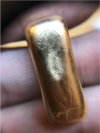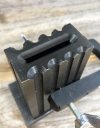purplepepper8
Member
Hey, Ive been struggling with this for a long time and haven’t found a solution- i keep getting cracks in my ingots while rolling. If you look at the images attached, you’ll see that the ingots always have these kinds of depressions/ crack like things when i pour them. The cracks show up maybe two seconds after pouring once the metal cools a bit. I have no idea why this is the case. Ive also noticed that the ingot ’sweats’ some liquid when annealing after the first few passes through the mill (I’m guessing the depression/ cracks result in water getting trapped inside, which then releases upon heating).
My process is as follows- I heat up the ingot mould till the oil on it starts to smoke, and then move the flame over to the metal. I heat that till it is liquid, throw in some boric acid powder and swirl it around, and then pour into the mould. I then quench it in water, pass it through the rolling mill, and anneal (by heating till red, letting it become black before quenching in water again) and then continue rolling until i reach the desired thickness.
Now most of the time (Id say 4/5 times) cracks form on the sheet. for whatever reason the 1/5 times it rolls out ok (even though the depressions you see in the image are always present). Ive tried different ingot moulds (iron mould, graphite mould), pouring slowly/ quickly, heating for a long/ short time after the metal has become liquid, using a hissing blue flame/softer flame, I’ve tried different alloys and karats. Ive also tried hammering the ingot a bit before annealing and then passing through the mill. The one thing ive found that usually reduces the size of the depression is if i hold the flame on the ingot for a few seconds after pouring. But even that doesn’t get rid of it completely. Ive tried tens of times and haven’t been able to figure a solution and im hoping someone here can help me out. Thank you
My process is as follows- I heat up the ingot mould till the oil on it starts to smoke, and then move the flame over to the metal. I heat that till it is liquid, throw in some boric acid powder and swirl it around, and then pour into the mould. I then quench it in water, pass it through the rolling mill, and anneal (by heating till red, letting it become black before quenching in water again) and then continue rolling until i reach the desired thickness.
Now most of the time (Id say 4/5 times) cracks form on the sheet. for whatever reason the 1/5 times it rolls out ok (even though the depressions you see in the image are always present). Ive tried different ingot moulds (iron mould, graphite mould), pouring slowly/ quickly, heating for a long/ short time after the metal has become liquid, using a hissing blue flame/softer flame, I’ve tried different alloys and karats. Ive also tried hammering the ingot a bit before annealing and then passing through the mill. The one thing ive found that usually reduces the size of the depression is if i hold the flame on the ingot for a few seconds after pouring. But even that doesn’t get rid of it completely. Ive tried tens of times and haven’t been able to figure a solution and im hoping someone here can help me out. Thank you









